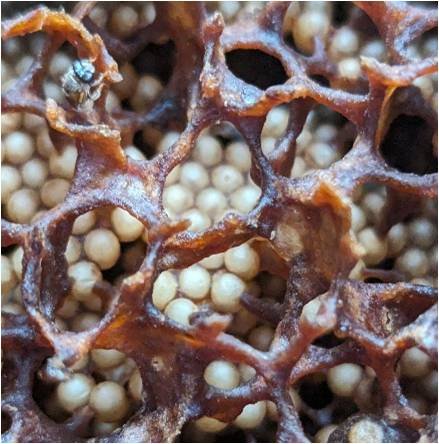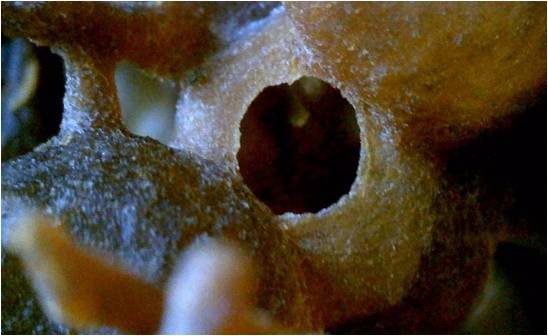Tetragonula iridipennis
Northeast India, a region rich in biodiversity and traditional practices, is now gaining scientific validation for its indigenous natural resources. A groundbreaking new study has shed light on the remarkable health benefits of honey and propolis derived from Tetragonula iridipennis, a unique stingless bee species native to Nagaland. This research not only underscores the therapeutic potential of these products but also opens promising avenues for boosting rural livelihoods and healthcare initiatives across the region.
Published in the esteemed International Journal of Entomology Research, the study by Pier Kepevitso and Dr. Rashmimala Kakoti from the University of Science and Technology Meghalaya provides crucial scientific validation for what Naga communities have long understood: their local bee products are special. The researchers conducted extensive biochemical analyses on honey samples, collected during both summer and winter, and propolis gathered from the bees’ hive structures in Nagaland. The findings were consistently striking, revealing that both the honey and the propolis of Tetragonula iridipennis are exceptionally rich in antioxidants. These natural compounds are vital for combating oxidative stress, a process linked to various chronic diseases, and are crucial for supporting overall cellular health.

Close-up of stingless nee brood cells
As Nagaland Stingless Bee Products Emerge as Potent Health Boosters, The study’s detailed analysis highlighted specific strengths: winter honey from Tetragonula iridipennis exhibited the highest phenolic content, measuring an impressive 128.97 mg GAE/kg, and demonstrated superior antioxidant activity, even outperforming standard ascorbic acid (Vitamin C) in certain tests. Meanwhile, the propolis samples showed the highest flavonoid content, reaching 75.83 mgQE/kg, coupled with significant radical scavenging and potent antimicrobial potential. These robust findings are not just scientifically significant; they underscore the profound therapeutic and commercial value inherent in these natural products from Nagaland.
For generations, Naga communities have practiced meliponiculture, the art of keeping stingless bees. While these bees produce smaller quantities of honey compared to their larger counterparts like Apis mellifera, their honey boasts a significantly higher concentration of bioactive compounds. Despite this inherent richness, the practice of meliponiculture has largely remained underdeveloped in the region, primarily due to a lack of scientific backing and market recognition. This new study fills that critical gap, providing the evidence needed to elevate these products to a commercial level.
As Nagaland Stingless Bee Products Emerge as Potent Health Boosters, The research also observed that the antioxidant activity of these bee products varied with the season, a correlation attributed to changes in the bees’ floral sources and the prevailing climatic conditions. This seasonal variation emphasizes the critical importance of implementing sustainable harvesting practices and integrating region-specific, traditional beekeeping knowledge to ensure both the quality and longevity of these valuable resources.

Stingless bee honeypot
Experts are quick to point out that these groundbreaking findings could serve as a vital foundation for promoting Nagaland’s stingless bee products as highly sought-after functional foods, nutraceuticals, and even effective topical therapeutic agents. Their potent properties suggest applications in areas such as wound healing and infection prevention. As Dr. Kakoti aptly stated, “It’s time we recognise the high medicinal value of indigenous bee products and integrate meliponiculture into rural development and health strategies.” This integration is poised to empower local beekeepers, enabling them to better commercialize their products and achieve fair market value.
With an escalating global demand for natural products rich in antioxidants, the study strategically positions Nagaland’s stingless bee honey and propolis to tap into lucrative niche health and wellness markets. This scientific validation not only promises to bring economic prosperity to local communities through enhanced scientific beekeeping and value addition, but it also heralds a new era where traditional knowledge is synergized with modern science to unlock nature’s full potential for human well-being. The buzzing of Nagaland’s stingless bees might just be the sound of a healthier, more prosperous future for the region.
Chief Minister Dr. Neiphiu Rio’s recent inspection of the National Highway-2 landslide site at Phesama wasn’t merely a routine visit; it was a potent demonstration of Nagaland’s unwavering commitment to building a more resilient and sustainable future. By insisting on long-term solutions over temporary fixes, and by pushing for the development of alternative, high-specification routes, the state government is directly confronting the persistent challenges posed by its unique topography and heavy rainfall. This forward-thinking approach, coupled with Dr. Rio’s emphasis on quality workmanship and meticulous planning, aims to transform Nagaland’s road infrastructure from a recurring liability into a robust asset.
The Chief Minister’s directives extend beyond immediate engineering concerns. His swift action to survey and provide disaster compensation for affected villagers highlights a compassionate governance model that prioritizes the welfare of its citizens alongside infrastructural development. The strategic importance of NH-2, particularly its role as a vital link to the Hornbill Festival’s venue at Kisama, underscores the urgency of these efforts. By fostering enhanced coordination among NHIDCL, district administration, and local stakeholders, Nagaland is setting a precedent for collaborative problem-solving that promises to yield lasting results. Ultimately, these comprehensive initiatives are not just about repairing roads; they’re about enhancing connectivity, bolstering economic growth, and projecting an image of efficiency and preparedness to visitors and residents alike. The path ahead for Nagaland’s infrastructure is challenging, but with this renewed focus and leadership, the state is firmly on track towards a more secure and accessible future.
